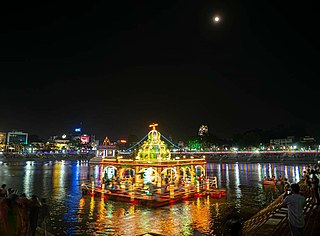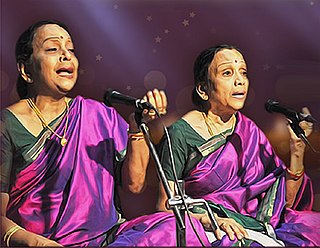Related Research Articles

The Hindu is an Indian English-language daily newspaper owned by The Hindu Group, headquartered in Chennai, Tamil Nadu. It was founded as a weekly publication in 1878 by the Triplicane Six, becoming a daily in 1889. It is one of the Indian newspapers of record and the second most circulated English-language newspaper in India, after The Times of India. As of March 2018, The Hindu is published from 21 locations across 11 states of India.

Madurai Shanmukhavadivu Subbulakshmi was an Indian Carnatic singer from Madurai, Tamil Nadu. She was the first musician ever to be awarded the Bharat Ratna, India's highest civilian honour and the first Indian musician to receive the Ramon Magsaysay award.

Mylapore, or Thirumayilai, is a neighbourhood in the central part of the city of Chennai, India. It is one of the oldest residential parts of the city. The locality is claimed to be the birthplace of the celebrated Tamil philosopher Valluvar, and the Hindu saint and philosopher, Peyalvar.

Madras Music Academy is one of the earliest established music academies in South India. Before the concept of infrastructure was introduced to India in the early 1920s, it was a gathering for elite musicians simply called Music Academy It plays an important role in encouraging and promoting primarily the Carnatic Music Indian art form. It played a vital role in the revival of the Indian classical dance form of Bharatnatyam in the 1930s when it faced near extinction due to a negative connotation caused by conservative societal standards.
The Hindu Higher Secondary School (HHSS), located on Big Street, Triplicane, Chennai, India, is one of the oldest secondary schools in South India, having been established in 1852. The school was founded at a time when many parents were reluctant to send their children to schools managed and run by the British, in this case, the English East India Company.

Thiruvallikeni known as Triplicane, is one of the oldest neighbourhoods of Chennai, India. It is situated on the Bay of Bengal coast and about 0.6 km (0.37 mi) from Fort St George. The average elevation of the neighbourhood is 14 metres above sea level.

The Telangana High Court is the High Court for the Indian state of Telangana. Founded by the 7th Nizam Mir Osman Ali Khan, initially, it was set up as High Court of Hyderabad for the then Princely State of Hyderabad Deccan and later renamed High Court of Andhra Pradesh, as it was set up on 5 November 1956 under the States Reorganisation Act, 1956. The Andhra Pradesh High Court was renamed as High Court of Judicature at Hyderabad in view of the bifurcation of Andhra Pradesh state.

Tamil Nadu Legislative Council was the upper house of the former bicameral legislature of the Indian state of Tamil Nadu. It began its existence as Madras Legislative Council, the first provincial legislature for Madras Presidency. It was initially created as an advisory body in 1861, by the British colonial government. It was established by the Indian Councils Act 1861, enacted in the British parliament in the aftermath of the Indian Rebellion of 1857. Its role and strength were later expanded by the second Council Act of 1892. Limited election was introduced in 1909. The Council became a unicameral legislative body in 1921 and eventually the upper chamber of a bicameral legislature in 1937. After India became independent in 1947, it continued to be the upper chamber of the legislature of Madras State, one of the successor states to the Madras Presidency. It was renamed as the Tamil Nadu Legislative Council when the state was renamed as Tamil Nadu in 1969. The Council was abolished by the M. G. Ramachandran administration on 1 November 1986. In 1989, 1996 and 2010, the DMK regime headed by M. Karunanidhi tried to revive the Council. The former AIADMK regime (2016-2021) expressed its intention not to revive the council and passed a resolution in the Tamil Nadu Legislative Assembly in this regard.

Kasinadhuni Nageswararao, better known as Nageswara Rao Pantulu, was an Indian journalist, nationalist, politician, businessman, and a staunch supporter of Khaddar movement. He participated in the Indian independence movement and in the Indian National Congress party, including Mahatma Gandhi’s civil disobedience movement through salt satyagraha. He was conferred with the title Desabandhu by the people of Andhra Pradesh. He was a major financier of Congress activities in Andhra and Chennai and is also known for patenting Amrutanjan. He was conferred with the title Desoddhaaraka by the Andhra Mahasabha. In 1935, the Andhra University honoured him with Kalaprapoorna, an honorary doctorate of Literature.

Ganapathy Dikshitar Subramania Iyer was a leading Indian journalist, social reformer and freedom fighter who led the Triplicane Six in launching The Hindu, an English newspaper on 20 September 1878. He was proprietor, editor and managing director of The Hindu from 20 September 1878 to October 1898. The Tamil language newspaper 'Swadesamitran' was also founded by him in 1882.

Rai Bahadur SirPanapakkam AnandacharluCIE was an Indian lawyer and freedom fighter who was a founding delegate and later president of the Indian National Congress, founder and president of the Triplicane Literary Society, and founder of the Madras Mahajana Sabha. He additionally aided the Triplicane Six in founding The Hindu, to which he was a frequent contributor.
Mudumbai Veeraraghavachariar (1857–1906) was an Indian journalist, freedom-fighter and teacher from the erstwhile Madras Presidency. He was one of the founding Triplicane Six of The Hindu newspaper and served as its Managing Director from 1878 to 1905.

The Bombay Sisters, C. Saroja and C. Lalitha (26 August 1938 – 31 January 2023), were an Indian Carnatic music singing duo. They received the Padma Shri, India's fourth highest civilian honour, in 2020.

Nyapathi Subba Rao Pantulu was an Indian politician and social activist who served as a member of the Madras Legislative Council between 1893 and 1909. He was also one of the Triplicane Six, founders of The Hindu, and General Secretary of the Indian National Congress from 1914 to 1917.
The Rudrapatnam Brothers are an Indian Carnatic vocal duo, consisting of brothers R. N. Thyagarajan and Dr. R. N. Tharanathan. The brothers come from a family of musicians from Rudrapatna village off the Kaveri banks in Arkalgud Thaluk of Hassan district in the southwest Indian state of Karnataka. Vocalist Tiger Varadachariar, on seeing the musical atmosphere there, once claimed that "Rudrapatnam is the Thanjavur of Karnataka". Music, Veda adhyayana, and studying Sanskrit were integral parts of their family tradition.
Adi Shankaracharya is a 1983 Indian film in Sanskrit language directed by G. V. Iyer. The film depicts the life and times of the Hindu philosopher, Adi Shankaracharya, who consolidated the doctrine of Advaita Vedanta (nondualism) in Hindu philosophy. This movie is prime example of experimental movie era of Kannada film industry. It was the first film in India to be made in Sanskrit. At the 31st National Film Awards, it won four awards, including Best Film, Best Screenplay, Best Cinematography and Best Audiography.
Nageswara Rao Park is a 4-acre (1.6-hectare) park located on Luz Corner in Mylapore, Chennai, India. The park, with a separate play area for children, is kept open to the public from 5 a.m. to 8 p.m. and is a popular place for morning walks among the locals. The park also hosts music kutcheris and civic forums, on the weekends all year round. The park has a badminton court. The park is maintained by Sundaram Finance.
T. L. Venkatarama Iyer was a Judge of the Supreme Court of India, a Carnatic musician and a musicologist.

The Mylapore clique or oligarchy was a small coterie, amounting to a "handful" of politically moderate, elite Brahmins, many of them noted lawyers, administrators, academics or educators, or industrialists, in the Madras Presidency, who 'wielded almost exclusive influence and patronage in the service and government appointments', 'controlled the flow of resources out of the institutions of the capital' and 'dominated the professional and political life of [the presidency].' Informal and exclusive, it was historically controlled by two extended families, the Vembaukum Iyengars, and the Calamur Viravalli-Chetpet Iyers, and took its name from the luxurious Madras City neighborhood in which many leading members kept mansions. The clique coalesced and began its dominance in the 1880s and 1890s under the headship of Sir V. Bhashyam Aiyangar and Sir S. Subramania Iyer, with R. Raghunatha Rao as a tertiary leader; while some argue that it reached its zenith between 1910 and 1920, others highlight its remarkable successes in ministry and magistracy continuing in the 1920s and 1930s, with Sir C. P. Ramaswami Iyer as leader.
Diwan Bahadur Mandayam Osuri Parthasarathi Iyengar, M.A., M.L. (1857–1926) was an Indian lawyer and magistrate who retired to private practice in 1913, from the role of District and Sessions Judge of Rajahmundry in the Madras Presidency, having served prior as Chief Judge and Third Judge of the Court of Small Causes, and as a judge of the Madras City Civil Court. He was born in 1857, and after graduating with a Bachelor of Laws in 1879 apprenticed with T. Rama Rao, before enrolling as a Vakil of the High Court of Madras. He subsequently graduated to the rank of Advocate, and was recognized as one of the leaders of the Appellate Side, along with C. R. Pattabhirama Iyer, V. Krishnaswamy Iyer, P. R. Sundaram Iyer, Sir V. C. Desikachariar, and Sir C. Sankaran Nair, immediately behind Sir V. Bhashyam Aiyangar and Sir S. Subramania Iyer, from 1891, prior to embarking on his judicial career in 1896. He was a member of the Madras Law College Council, and reportedly led the Triplicane Clique. He was uncle to M. O. P. Iyengar and M. O. T. Iyengar.
References
- ↑ "The Hindu: Board Room Becomes Battlefield". Forbes India. Retrieved 2024-03-26.
- ↑ Muthiah, S. (2023-09-20). "The Hindu experience: From our archive". The Hindu. ISSN 0971-751X . Retrieved 2024-03-26.